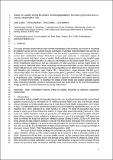Indoor air quality among Mumbai's resettled populations: Comparing Dharavi slum to nearby rehabilitation sites
Author(s)
Lueker, Justin; Bardhan, Ronita; Sarkar, Ahana; Norford, Leslie
DownloadAccepted version (1.534Mb)
Publisher with Creative Commons License
Publisher with Creative Commons License
Creative Commons Attribution
Terms of use
Metadata
Show full item recordAbstract
© 2019 This study presents results from an experimental investigation of the severity and sources of household air pollution across two low-income housing archetypes in Mumbai. Experimentation was carried out in Dharavi—one of the world's largest slums—and two nearby communities representing Mumbai's current slum resettlement scheme. Household surveys were conducted to understand aspects of occupant behavior that impact indoor air quality. Multi-pollutant logging sensors were installed inside units and in nearby outdoor locations to measure concentrations of particulate matter (PM2.5) and CO2. While rehabilitation architecture and gas cookstoves are often assumed to provide higher indoor air quality than in traditional slums, field monitoring and occupant behavior surveys demonstrated that indoor pollution levels were consistent across the two typologies even after infrastructure enhancements and ubiquitous gas cookstove usage. Indoor PM2.5 measurements ranged between 150 and 300 μg/m3, substantially higher than World Health Organization (WHO) guidelines. PM2.5 indoor/outdoor (I/O) ratios spiked during cooking periods but were otherwise less than 1.0 in over half of logged instances in rehabilitation units, highlighting the role of particle deposition phenomena and ambient-sourced PM2.5 in indoor environments. To minimize the impact of both indoor and outdoor pollutant sources while respecting culturally-normative occupant behavior, this study points to the need for architectural design guidelines and enhanced indoor air quality interventions.
Date issued
2020Department
Massachusetts Institute of Technology. Tata Center for Technology and Design; Massachusetts Institute of Technology. Department of ArchitectureJournal
Building and Environment
Publisher
Elsevier BV